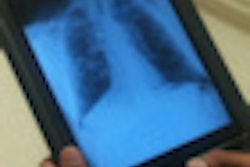A research team from Brigham and Women's Hospital in Boston is making the case that PACS does indeed qualify as "meaningful use" of healthcare IT under the U.S. government's IT stimulus program. The study helps support the claim that radiology should be eligible for up to $1.5 billion in meaningful use funds.
While medical imaging isn't specifically included in stage 1 of the meaningful use program, many believe that RIS and PACS technology can be shown to meet the measures and objectives of meaningful use. Radiology advocates have been asserting that imaging informatics qualifies under the government's meaningful use criteria, with each diagnostic imaging professional in the U.S. eligible for as much as $44,000 in funding through 2015 -- some $1.5 billion in total.
In a study presented at the 2010 RSNA meeting in Chicago, Brigham and Women's researchers provided data that help support radiology's argument. In an analysis of their institution's experience with enterprise-wide PACS, the study group found that PACS was used with increasing frequency by a variety of clinicians across departments, medical settings, and locations. In addition, usage of PACS functionality grew while film costs decreased, said Katherine Andriole, PhD.
"Meaningful use of an enterprise PACS was demonstrated," Andriole said.
The Brigham experience
Meaningful use of healthcare IT is believed to improve quality, safety, and efficiency of patient care, as well as reduce costs, Andriole said. As a result, the researchers set out to demonstrate the meaningful use of an enterprise-wide PACS through measures of technology adoption, use, and reduction in film costs from 2003 to 2009.
Brigham and Women's Hospital is a 751-bed, urban, tertiary-care teaching hospital that provides inpatient, outpatient, emergency, trauma, and oncology care. The institution's healthcare enterprise includes a community hospital and an oncology hospital, along with outpatient, primary, and specialty care practices. In 2009, 650,000 imaging exams were generated.
In 2003, the institution implemented an enterprise-wide Web-based PACS network, offering distribution and display of medical images and reports. The PACS was accessible by all healthcare providers throughout the system, and the archive stores radiologic, cardiac, and other images such as intraoperative surgical images and some dental studies, Andriole said.
The researchers measured the use of PACS and its effect on film cost by prospectively capturing data logs from 2003 to 2009 and analyzing financial ledgers. Adoption was measured across the healthcare enterprise by use (number of log-ins), user specialty, access location, time of access, and functionalities used.
Approximately 37,000 users across the enterprise utilized the system over the study period. The 650,000 exams generated a year include approximately 90 million images that take up 30 terabytes of storage space. Seven years of image data are available online.
In total, the institution has 4.5 million archived exams (about 500 million images), much of which are stored in nearline storage and are immediately available, Andriole said. In that seven-year period, clinicians across all specialties and settings used the system 1,867,847 times.
"[PACS] was utilized most by our emergency department, followed by inpatient providers accessing the Web PACS, as well as surgeons," she said.
Emergency department providers had 357,584 total log-ins, while inpatient providers had 141,210 log-ins and surgeons had 125,565 log-ins. By user type, 93% were physicians, 3% were physician assistants, and 2% were nurses.
The number of log-ins increased between 2003 and 2009 by a statistically significant amount (p < 0.001).
Increase in functionality
An increase in the use of PACS functionality was also found over the study period. For example, search requests for a patient's list of radiological exams grew from 12% (52,302 of 440,072) of the total imaging studies to 200% (1,067,519 of 525,359) in 2009.
"This really accounted for multiple clinician views of the same study, or multiple clinicians viewing at different times or viewing it again," Andriole said.
In 2003, clinicians viewed radiology reports on PACS only 0.5% of the time (2,374 of 440,072 exams). By 2009, however, nearly half (47%) of radiology reports were being viewed on the PACS (207,067 of 525,359).
In 2003, only 6% (26,280 of 440,072) of the total imaging exams were viewed by clinicians. But that increased to 157% (822,595 of 525,359) in 2009, again showing multiple clinician views of the same study.
All of these increases were statistically significant, Andriole said.
Even as exam volume climbed from 440,072 exams in 2003 to 525,359 in 2009, film costs decreased from $269,459 in 2005 to $41,896 in 2009.
Andriole noted that enterprise PACS was used across multiple specialties (including surgery, medicine, emergency medicine, oncology, and primary care) and multiple healthcare settings and locations (emergency, inpatient, outpatient, specialty care, community hospital, and private practices that order imaging at their facilities).
"If you build it, they will use it," she said.
Although the effect of PACS on patient care was not specifically studied, the statistics do show a significant increase in its utilization.
"One could surmise that physicians would not be continuing to use the system if it wasn't helping them in their patient management," she said.
By Erik L. Ridley
AuntMinnie.com staff writer
January 24, 2011
Related Reading
Many hospitals, doctors plan to adopt EHR, January 14, 2011
Leaders in Imaging: A conversation with Keith Dreyer, DO, PhD, November 17, 2010
ONC clarifies 'meaningful use' certification rules, September 30, 2010
CHIME: Meaningful use goals seem achievable in 2011-12 ... maybe, September 20, 2010
KLAS: RIS purchases are priorities for hospitals, September 9, 2010
Copyright © 2011 AuntMinnie.com




















